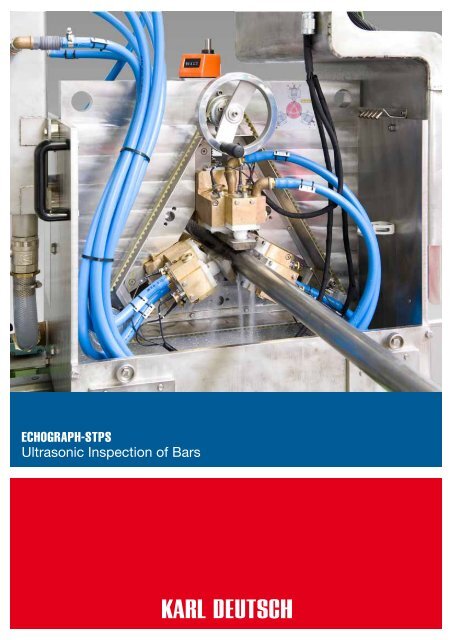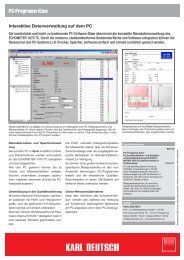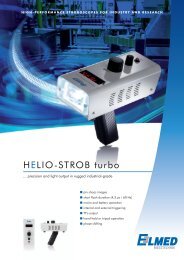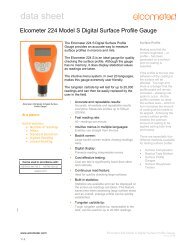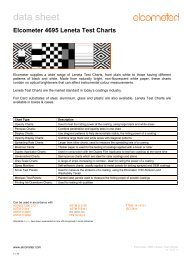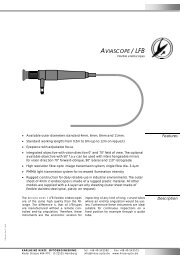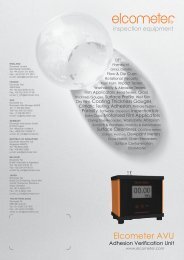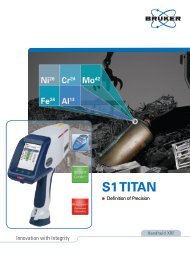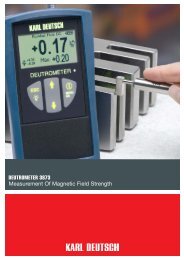ECHOGRAPH-STPS Ultrasonic Inspection of Bars - Karl Deutsch ...
ECHOGRAPH-STPS Ultrasonic Inspection of Bars - Karl Deutsch ...
ECHOGRAPH-STPS Ultrasonic Inspection of Bars - Karl Deutsch ...
Create successful ePaper yourself
Turn your PDF publications into a flip-book with our unique Google optimized e-Paper software.
<strong>ECHOGRAPH</strong>-<strong>STPS</strong><br />
<strong>Ultrasonic</strong> <strong>Inspection</strong> <strong>of</strong> <strong>Bars</strong>
<strong>ECHOGRAPH</strong>-<strong>STPS</strong><br />
<strong>Ultrasonic</strong> <strong>Inspection</strong> <strong>of</strong> <strong>Bars</strong><br />
<strong>ECHOGRAPH</strong>-<strong>STPS</strong> bar testing system<br />
Testing principle (9 probes):<br />
3 straight-beam probes<br />
6 angle probes<br />
<strong>Ultrasonic</strong> <strong>Inspection</strong> <strong>of</strong> <strong>Bars</strong><br />
KARL DEUTSCH has developed ultrasonic<br />
testing equipment since 1951 and<br />
has shipped the first inspection system<br />
for automated billet inspection in 1965.<br />
Many improvements on the <strong>ECHOGRAPH</strong>electronics,<br />
the robust testing mechanics<br />
and the ultrasonic probes have led to our<br />
current state-<strong>of</strong>-the-art. KARL DEUTSCH<br />
maintains a strict quality management system<br />
according to DIN EN ISO 9001:2000.<br />
High throughput rate and in operation worldwide!<br />
Detection <strong>of</strong> internal flaws is carried<br />
out with straight beam probes. For bar diameters<br />
greater than 30 mm, surface-near<br />
flaws are detected by angle beam probes.<br />
Key properties for the <strong>ECHOGRAPH</strong>-<strong>STPS</strong><br />
bar inspection system are the high testing<br />
speed <strong>of</strong> up to 2 m/s and the simultaneous<br />
adjustment <strong>of</strong> the probe carriers producing<br />
short change-over times. The coupling <strong>of</strong><br />
the ultrasound is achieved with guided water<br />
jets. The squirter probe holders for the water<br />
jet coupling allow test conditions comparable<br />
to immersion testing.<br />
The inspection <strong>of</strong> the core region is carried<br />
out with three to five straight-beam probes.<br />
All probe holders are equally positioned<br />
around the bar circumference. The probe<br />
holders are mechanically protected by guiding<br />
skids usually made from hard-metal.<br />
The skids are<br />
also responsible for stable coupling and testing<br />
conditions by guiding the probe holders<br />
along the bar surface. Unavoidable mechanical<br />
straightness tolerances <strong>of</strong> the bars are<br />
compensated for by the spring-loaded suspension<br />
<strong>of</strong> the probe holders.<br />
Additional probes inspect the surface-near<br />
region for bar diameters above 40 mm. An<br />
angled position <strong>of</strong> the probe with respect to<br />
the bar surface results in angular ultrasound<br />
transmission in the circumferential direction<br />
<strong>of</strong> the bar. Each probe holder contains one<br />
probe which transmits into the clockwise<br />
direction; a second probe transmits counterclockwise.<br />
The testing mechanics is mounted on a<br />
height-adjustable test table. A horizontal<br />
support (sliding device) is mounted onto the<br />
test table which is used to move the test mechanics<br />
between test position (in-line) and<br />
calibration position (<strong>of</strong>fline). Calibration and<br />
service work can then be carried out without<br />
disturbing the on-going production.<br />
The feeding and discharging <strong>of</strong> the bars is<br />
carried out by a roller conveyor which is supplied<br />
by the buyer. Also an automated sorting<br />
<strong>of</strong> the tested bars (good and bad sorting) is<br />
supplied by the buyer. Typically, the ultrasonic<br />
inspection system is combined with an<br />
eddy current or a strayflux testing system for<br />
the detection <strong>of</strong> surface defects. A common<br />
data protocol can be provided (option).<br />
The STP-System works with three probe carriers (couplant<br />
wipers and protection housing <strong>of</strong> the system are<br />
dismounted in this picture). Each probe carrier holds<br />
one probe for normal incidence. Two angle beam probes<br />
can also be integrated in each probe carrier for<br />
detection <strong>of</strong> surface-near flaws.<br />
Detailed view <strong>of</strong> the probe carriers with water supply.<br />
The guidance on the bar surface is achieved with hardened<br />
skids.
<strong>ECHOGRAPH</strong>-<strong>STPS</strong><br />
<strong>Ultrasonic</strong> <strong>Inspection</strong> <strong>of</strong> <strong>Bars</strong><br />
Optional probe configuration with 15 probes<br />
a) 5 straight-beam probes<br />
b) 10 angles beam probes<br />
Testing mechanic with 15 probes for round bars<br />
(currently equipped with pentagonal calibration block)<br />
Testing mechanic with 4 probes for quadratic pr<strong>of</strong>iles<br />
Testing mechanic with 3 dual-element probes for flat pr<strong>of</strong>iles
<strong>ECHOGRAPH</strong>-<strong>STPS</strong><br />
<strong>Ultrasonic</strong> <strong>Inspection</strong> <strong>of</strong> <strong>Bars</strong><br />
Bar testing system with water filter unit, test table and operator panel.<br />
Specimens<br />
Round or hexagonal bars<br />
Material<br />
continuous cast, ingots<br />
Processing stage<br />
rolled, drawn, extruded, turned or grinded<br />
Diameter range (D)<br />
8 to 130 mm<br />
Length<br />
min 2.5 m<br />
Ovality<br />
max. 2% <strong>of</strong> D<br />
Straightness deviation<br />
max. 2 mm/m<br />
Surface condition<br />
rolled or better<br />
Temperature max. 60 °C<br />
Slab ends<br />
machined, no burr<br />
Detectable flaws<br />
internal flaws 0.8 - 2 mm FBH (dependent on diameter)<br />
PI <strong>STPS</strong> e 2010 04 • Subject to change without notice • Printed in Germany<br />
KARL DEUTSCH Prüf- und Messgerätebau GmbH + Co KG<br />
Otto-Hausmann-Ring 101 · 42115 Wuppertal · Germany<br />
Phone (+49 -202) 7192-0 · Fax (+49 -202) 7149 32<br />
info@karldeutsch.de · www.karldeutsch.de<br />
DIN EN ISO<br />
9001:2000<br />
c e r t i f i e d


